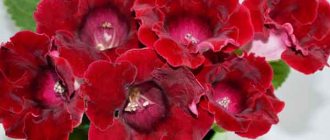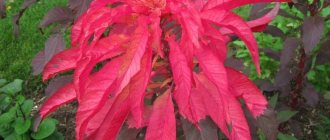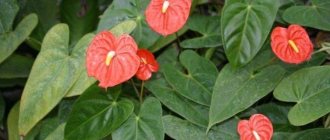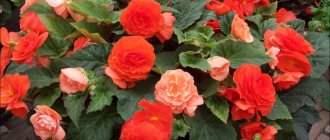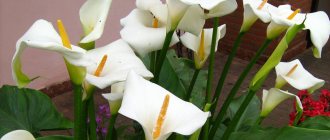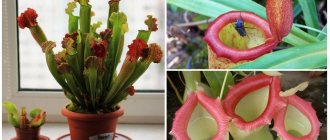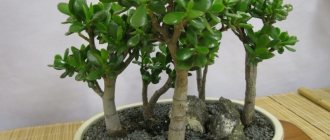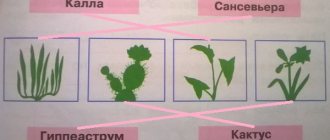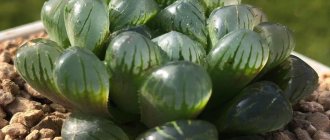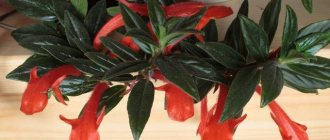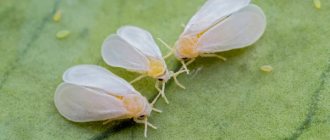The red flower with a yellow pistil is one of the most beautiful of indoor plants. Experienced flower growers will always have such a flower in their collection. For beginners, it causes some fear and trepidation.
One of the legends is associated with Anthurium. The formidable leader decided to marry a girl from the neighboring tribe. She refused his proposals. But such an answer meant nothing to the leader, and he forced the girl to marry him. According to tradition, a fire was lit on the wedding day, and the beautiful girl threw herself into it out of misfortune. But the gods took pity on the poor thing. After that, she was turned into a red anthurium.
Among the people, Anthurium has many names: the tongue of the devil; male happiness; flamingo flower; pig tail. The plant is considered the flower of family happiness, which brings stability in relationships and harmony. It is a symbol of male happiness, as it has the ability to attract the energy of a young man into the home of an unmarried girl.
Getting to know Anthurium
The flower belongs to the Anthurium genus, of which there are more than 1000 species in nature. Anthurium is an evergreen plant. Grows on trees, has aerial roots. The plant blooms at home all year round (in good light, of course). A flower on Anthurium can last for about 2 months. South America is considered the birthplace of the plant. Anthurium grows in South American and tropical forests. The optimal temperature is about 10 degrees. The air should be humid: from 70 to 90%. The plant in nature develops under the forest canopy and is not exposed to direct sunlight.
Anthurium flower - description
In general, strictly speaking, anthurium is not a specific plant, but a genus of plants, so you can often see different names: pink fair, black paris, princess Amalia, et cetera. All these flowers are very different from each other.
The most beautiful, bright flowers of this species are cultivated for growing in the garden or at home. They are sometimes called “flower of family happiness” or “male flower”, “flamingo flower”.
Anthuriums have a variety of leaves: from one centimeter to a whole meter long, whole and dissected. They are often endowed with bright colors, interesting veining or a satiny, metallic, silvery tint. The same can be said about flowers. They are usually tiny and form something similar to a long, dense ear. Hence the name of the genus: the word “anthurium” consists of two roots: “tail” and “flower”.
Later, this cob is covered with bright, juicy fruits, similar to berries.
Due to the large number of varieties and beauty, anthurium is very popular for bouquets, despite the fact that caring for the plant is quite difficult.
Poisonous or not: yes, poisonous. It does not emit toxic fumes, but if the juice gets on the skin or mucous membranes, there will be inflammation. Therefore, it is better to touch the green pet while wearing gloves, and also keep animals and children away from it. There are no more dangers.
Why is it called “male happiness”
Because of that very “tail” covered with flowers. It is phallic in shape, bright in color, and is therefore associated with the male genital organ. Anthurium comes from Mexico, Paraguay, and other southern countries, and there the cult of the phallus is very developed. Therefore, it is believed that anthurium helps to improve a man’s abilities in the field of sexual interactions, improve a couple’s relationship, create passion, and if a lonely girl gets such a flower, it will certainly attract a man to her.
How anthurium blooms
Depends on the subspecies, for example, Anthurium andre blooms all year round. However, most members of the genus bloom in winter; some subspecies – from February to October-November.
Usually it is very beautiful: large, unusually shaped, dense, bright leaves, a brightly colored flower cloth up to ten centimeters in volume, the cob itself - everything together looks exotic and attracts the eye.
How many years does he live?
Without renewal (feeding, trimming old leaves, transplanting into another pot), the anthurium lives up to four years, then the development of the flower slows down significantly; care must be taken to refresh the appearance and strengthen the health of the plant.
Home care
The plant should be properly cared for, then it can grow up to about 70 cm in height and 1.5 meters in width, while blooming almost all the time. After the flower is at home, it should be placed in a bright and warm place. It is important that the place allocated for it is not too “hot”. It takes about 11 days to get used to home conditions. During this time, soil moisture is taken under control. The plant should be sprayed with warm water every day. Avoid getting drops on the bract. After this, the flower must be transplanted into fresh soil. It is recommended to very carefully inspect the roots and free them from the manufacturer's substrate. Then carefully get rid of the sponge, which is usually located between the roots.
Reproduction of spathiphyllum
Reproduction occurs by dividing the bush and seeds. It is very convenient to perform this procedure during transplantation. You need to divide the plant very carefully so as not to damage anything, otherwise the cuttings will not take root.
Seeds
A rather advantageous feature of red spathiphyllum is that it can be grown from seeds. However, in order for them to form, it will be necessary to take care of this initially.
It is necessary to carry out the process of pollination of flowers. It involves the transfer of pollen from one flower to another. To perform this operation, you will need a swab with a cotton tip or a brush with a certain softness. Pollination manipulations should be repeated several times over several days. Patient housewives will wait for the formation of colorful berries 10-11 months after the operation. However, in this matter you should still be patient until the seeds form.
To do this, the seeds need to be removed from the berries and washed under running water. Then you should make a 0.1% solution of potassium permanganate. Seeds are sent into it to prevent mold from growing on them. They should remain in the solution for 2 hours.
Since the seeds lose their ability to germinate within a short time, they must be sent to a shallow container, the bottom of which is covered with slightly damp foam rubber. The top of the vessel should be covered with a plastic bag or glass lid. After germination, the seeds need to be planted. This procedure must be performed 3 or 4 times. Picking is done in a high-quality soil mixture. Seedlings should be placed at a distance of 1.5 cm from each other each time.
After the seedling reaches 7-8 cm, you need to transplant it one last time. A vessel with a volume of 0.2 liters will be suitable for the flower. With proper care, the seedling will begin to actively grow and will require another transplant in 11-12 months.
Dividing the bush
The resulting cuttings should not have wilted leaves: they should be cut off immediately. If there are no roots when dividing, then the plant should be placed in water for 3 weeks and wait until it takes root. The length of the roots should be at least 2-3 cm, then the plant can be planted in the soil. If you do not need the plant to grow too much, then on the division you need to leave one growth point and a rhizome.
It is better to divide at a warm air temperature: +20-21 °C.
Make sure that each rhizome has several leaves: at least 2-3. The delenka needs to be planted in a pot whose diameter will be 15 cm, no more. The pot must first be filled with the substrate described above. Carefully observe all proportions. Some gardeners also recommend the following substrate: leaf soil, coniferous soil, a layer of humus, peat and sand. The ratio is as follows: 2:2:2:2:1.
Temperature and humidity
The flower is a heat-loving plant. A good temperature is considered to be 20 C. As for winter time, the optimal temperature for anthurium is 18 C. At 15 degrees he begins to feel unwell. The sprayer should be used regularly about 2 times a day. Anthurium does well in cool rooms such as the bathtub. In the summer, the flower is usually placed outside and placed in a place where there is no direct sunlight. During the flowering period, Anthurium needs fertilizer. It is recommended to carry out this procedure about 2 times a month in winter, and once every 11 days in summer.
Description of the variety
Sometimes you can hear that nurseries offer spathiphyllums with red or pink bracts. However, before you succumb to a tempting offer and rush to purchase a rare flower, it is worth understanding the classification. The white cover of a flower can only become colored under the influence of chemicals artificially introduced from the peduncle.
Important! Under natural conditions, the bract can only turn green.
And yet there are plants that are closely related to spathiphyllum and have colored perianth. These are anthuriums well known to gardeners. Thanks to breeders, depending on the variety, they are able to please the owner with scarlet, burgundy, pink and almost white covers of inflorescences. Spathiphyllum and anthurium have many common morphological features. Therefore, in the West, the common name is applied to plants - peace lily.
Spathiphyllum, like many plants living in tropical and subtropical zones, does not shed its leaves all year round, remaining green and attractive. The leaves of the plant are quite large, elongated-lanceolate, with depressed veins and a glossy surface.
Since spathiphyllum has practically no stem, or it is very shortened and spreads along the ground, the leaves rise directly from the ground. And during the flowering period, graceful peduncles with white bracts surrounding a white or yellowish cob rise above the plants. Contrary to popular belief, the photo shows not a spathiphyllum flower, but its inflorescence. But small flowers collected in a cob have neither petals nor external attractiveness.
Watering
In the summer, when plants are actively developing, the soil should be kept evenly moist. During this period, Anthurium “will not refuse” a warm shower, where the water temperature will be approximately 40 degrees. It is worth noting that if there is excess water on the pan, it must be drained. In winter, it is necessary to limit watering to a minimum. In this case, the top layer of soil usually dries out between waterings to a depth of about 3 centimeters. Due to its rather large roots, Anthurium is able to retain a small supply of water. In addition, the flower can tolerate drought for some time. If you flood it, it can have a very bad effect on it. It is recommended to use settled water for irrigation.
What does a flower bring to the house, male happiness: signs and superstitions
According to signs, anthurium:
- Increases income, brings financial well-being;
- If a husband has offended his wife, the wife should put his thing near the anthurium - the husband will be ashamed;
- Anthurium flowering out of season means husband’s betrayal;
- If the anthurium “cries” (drops of water appear on its leaves), it means that the spouses no longer love each other;
- If it withers, it means that the man of the family will soon fall ill;
- Rotting roots mean a secret enemy;
- If it has dried up, it means that the man is not respected here;
- Attracts prosperity, happiness, success, a strong, happy marriage.
- The leaves have turned yellow, which means that the couple will soon quarrel.
Also, according to popular belief, anthurium helps men in everything. The proximity of this flower will supposedly help a man quit smoking, strengthen potency, become more successful at work, become calmer and happier. Anthurium helps women become sexier, richer and attract the desired man.
Transplant technology
- Before starting the procedure, the flower should be watered. This is necessary to make it easier to remove the plant from the pot.
- Remove the earthen lump from this container.
- Carefully examine the root system of the plant.
- If any damage is detected on the roots, cut it off. The remaining roots need to be processed.
- Pour drainage (1 centimeter) and a small amount of soil onto the bottom of the pot. Install the flower, then sprinkle with soil to the end of the pot.
- This is done by watering after a while. It is recommended to water the flower only when the first 2 layers of soil dry out.
Feeding, fertilizers, hygiene
Experienced gardeners know that anthurium should be fed in spring and summer. Fertilizers for orchids will suit him well. Feeding is done about 2 times a month. It is necessary to wipe the leaves from dust with a damp cloth 2 times a week. Experts recommend giving the flower a warm shower once every 3 months. In addition, you should promptly prune inflorescences that have faded.
Propagation and pruning
The flower must be divided every 3.5 years. It does not live in pots alone for more than this period. Usually they divide it into 2 parts (so that the new plant is lush) or into several parts at once. A sign of this is the dropping of leaves.
There are 2 ways to propagate Anthurium: cuttings and seeds. Method 1 . It is necessary to cut the stem upward and place it for rooting in a small container with moist soil. Method 2 . To do this, you need to sow the seeds in moist soil. But before that, you need to keep them for about 1.5 hours in a weak solution of potassium permanganate to prevent mold, placing them in a warm place. It is worth noting that they take a long time to germinate. The first shoots appear only after 2 months. After small anthuriums grow 6 centimeters, they need to be planted in separate containers. The seeds can be soaked first by placing them on damp foam, which should be kept constantly wet. When the seeds germinate, they are planted in the ground. Usually the plant is not pruned. Flower growers remove only those leaves that have lost their attractiveness.
Reproduction
Cuttings are the easiest and most effective way to propagate clerodendrum.
In the spring, young shoots are cut from the plant and planted in a mixture of sand and peat, covered with glass or plastic film and set up in a small greenhouse.
Recently, flower shops have been selling ready-made greenhouses and greenhouses - they are very convenient and will last for many years.
Calla lilies and Spathiphyllium are very similar to red anthurium, whose beautiful green leaves turn white during flowering. The modest, delicate spathiphyllum and its picturesque antipode, anthurium, look great together.
Anthurium Amaretti has a white inflorescence with red spots . The blanket contains different colors:
- red;
- orange;
- yellow.
green;
The compact Anthurium Andrianum Edison has wide, rich green, heart-shaped leaves. It has tall peduncles that rise above the bush. A round leathery blanket surrounds a yellow or white cob.
The low Anthurium Nano Red forms a spreading bush with small growing points . It has pointed dark green leaves. The peduncle is straight, rising above the bush. The upright cob has a reddish-orange hue. The color of the small heart-shaped blanket ranges from reddish-green to crimson.
Common diseases
Lack of proper flower care causes the following problems:
- If the leaves become dark, then there is excess lighting in the room.
- If the leaves of the plant are yellow or brown, the reason is low air temperature.
- If a flower rarely blooms, it means that it does not have enough light, and also lacks the appropriate substances.
- If black or brown spots appear on the leaves, the cause is overwatering.
- If the leaves of a flower curl, this indicates an excess or lack of lighting and low air humidity.
- If the tips of the leaves begin to turn yellow, it means there are drafts and dry air in the room.
- If the leaves turn black, it means there is a large amount of calcium in the soil and hard water is present.
The meaning of anthurium in the family
The plant carries only favorable energy. In the house, the plant creates an atmosphere of stability and harmony in the family. To enhance this beneficial effect, you should purchase spathiphyllum (considered a female flower).
It is worth noting that such a plant helps young people improve their health and gives masculine strength. In addition, anthurium helps people who suffer from heart-related diseases, as well as chronic fatigue syndrome.
If the family has problems related to finances, it is recommended to purchase 3 of these flowers and monitor their care very carefully. After all, healthy and large flowers will attract money to the house.
Popular types of Anthurium with photos and descriptions
Anthurium is a popular flower; it has many diverse, beautiful plants that are used to decorate rooms. Below you will read a brief description of the forty most popular varieties of “male happiness”.
Andre or Andrianum
A bright flower sail, similar to a heart due to its shape and rich red color, dense green leaves, flowers on the “tail” appear white, soft pink, yellow.
Champion
There are three varieties: pink (lush, with a soft green or yellow cob), “royal” (bright, round sail, with curved edges, “royal” carmine shade, pink cob), white – graceful, similar to a lily or orchid .
Fiorino
The sail is painted bright purple with a delicate lilac tint, it looks spring-like bright, at the same time gentle, similar to fuchsia.
Picasso
An amazingly beautiful flower: a bright, almost alien color, it almost glows. The subspecies “Princess Alexia” also has this coloring.
Jolie
Usually the sail of the antirium is flat, only slightly curved at the tips, but the Jolie is curved much more strongly, triangular in shape, similar to a boat. The reverse is a soft grassy shade, and the sail is soft pink.
Vanilla
A lush bush with dark, rich green, large leaves and a delicate lemon meringue-colored sail - an elegant, delicate, sophisticated combination.
Princess Amalia Elegance
Deep pink cob, pink sail, like a warm sunset over the southern sea, with red veins. The leaves curve gracefully downward, emphasizing the brightness of the sail.
Simba
It is interesting because of its unusual shape, which no longer resembles a heart, but rather the mane of a lion. Closer to the cob it acquires a grassy green tint, and the main web is white. The cob is dark pink.
Dakota
A large, lush flower almost two meters high with a large yellow spadix and a wide sail. Colors range from pale pink to deep crimson.
Livium
This hybrid attracts with its unusual color structure: it is painted as if in stripes, white in the center, and on the sides there are alternating dark pink and white veins, which is why it looks like (sorry for the unromantic comparison) a cut red onion.
Turenza
A lush bush with a bright scarlet, beautiful, rich shade, like an expensive women's lipstick, sail. Tall, reaches half a meter. The color of the cob is dark yellow, almost orange.
Cavalli
The sail of this type has a delicate, bright color - a combination of purple and pink, rare in nature, will be an interesting accent for a cold, calm interior in light colors.
Zizou
Large, oblong leaves, a small number of flower webs, dusty purple, discreet but elegant.
Mystic
This hybrid is very similar to Livium, but here the dominant color is white, and in the center there is a rich, dark pink color. The cob is large and thick, dark pink.
Black Love
An elegant flower in the Gothic style: the floral fabric appears black, the color of dark wood, only in the light it acquires a crimson tint and an elegant glossy shine. The leaves are also dark.
Black Queen or Black Prince
Hybrid of "Black Beauty" and "Otazu Brown". Its difference lies in the fact that the sail of this variety is two-colored: black and deep burgundy alternate. At the same time, the “tail” cob is grassy green, which makes an interesting contrast.
Black Paris
Also a black hybrid, but with a large yellow cob (black at the end), it differs from others in curved, spoon-like flowers and leaves.
Utah
The brightest, richest, darkest variety compared to the similar “Utah” Fiorino and Cavalli. Its shade is a combination of violet with red-violet, purple, and the spadix is lilac - a flower of royal tones.
Dynamite ed.
This variety really makes an impression like an explosion, due to its bright, expressive, immediately noticeable scarlet color and elegant shape.
Colorado
A cheerful, bright flower will lift your spirits every time you look at it: its color is similar to a sunset over a warm sea.
Aramon
A very elegant flower: the floral fabric is noticeably curved, looks dense, glossy, deep, noble crimson shade.
Renoir
At the same time discreet, but elegant and tender: a wide floral canvas, grassy green on the sides, but white in the center with pink veins. Fits well into a Provence style interior.
Leganza
This variety of anthurium has more leaves than other varieties, and it is also interesting because of its color change: at the cob it changes from yellow to orange, and the pink sail is bordered by grass-green.
California
The flowers of this subspecies of anthurium are one of the largest in size among all other subspecies. Their color is dark pink, almost red.
Adios spring
A fresh, sleek look: the sail is shaped like a card suit of spades, white in the center, but towards the edges there is a smooth transition to dark green.
Pandola
A miniature variety of anthurium, well suited for an apartment. At the same time, the leaves are large, and the sail has an interesting color: orange with a soft, creamy-pinkish tint.
Fantasy lava
This hybrid combines three different colors at once: white, delicate, almost transparent green and deep pink veins. At the same time, the leaves are dark green, malachite, almost blue.
Spirit
The delicate, creamy pink shade of the floral fabric is adjacent to large, dark, slightly curved leaves, looking exotic and elegant.
Hot Lips
Delicate, spring image: an equal number of leaves and flowers, a dark pink cob, and the sail is white with a pink tint, with a wide pink stripe in the middle.
Beauty black
Large inflorescences in dark chocolate shade. It looks unusual, immediately attracts attention, and is suitable for the interior of a loft apartment.
Sweet dreams
A truly sweet dream - the sail of this anthurium is bright, pink, similar to the scales of an exotic fish, with barely noticeable round pink veins.
Otazu brown
Another unusual variety: its sails are a rich burgundy shade, balancing on the verge of dark brown; the burgundy shade takes on a burgundy shade in the light.
Exota
It looks really exotic: the center is bright pink, and towards the edges it smoothly turns to white, having managed to be a little soft green. Miniature variety with a small number of flowers.
Baby Purple
A bright, attractive combination of noble malachite green and purple, with white veins, all with a glossy sheen.
Sierra Magic
A miniature hybrid, the flowers are small, but there are a lot of them - up to ten pieces, with yellow ears. Sails can be carmine, pink, white.
Jaguar green
This hybrid is interesting because of its unusual combination: its leaves and flowers are the same color – green, but with pink veins on the coverlet.
Royal ed
Dark, large, round leaves, round “sails”, balancing on the verge of a combination of deep red and carrot.
Purple love
White floral canvas with delicate lilac, almost pink, lilac veins, looks very delicate, suitable for a white and lilac interior.
Maine
The flower fabric of this anthurium is heart-shaped, warm pink, with pronounced textured veins, the spadix is white.
Violet Hart
The noble purple color of the sail, a bright glossy shine that gives it a more expensive look and attracts attention, a graceful curve, an expressive heart shape, a large white cob with a green end.
Madural orange
Large, slightly curved flowers with veins attract attention with their glossy shine, looking like delicious caramel apples.
Elido
Miniature, graceful, white variety of anthurium: a bright combination of dark greenery and delicate, medium-sized, white inflorescences, similar to tea roses.
Pink Fever
A distinctive feature of this variety is its graceful boat curve, soft, warm pink hue, large pink cob, and the predominance of leaves over inflorescences.
Michigan
Miniature variety, suitable for apartments. Red-orange large “sails” of an expressive, sharp shape with white veins.
Karma purple
Deep red-violet shade of the floral fabric, elegant spoon curve, unusual silhouette of the plant in the interior, bright glossy shine.
Baby boomer
A combination of two noble tones: rich carine, even crimson, along the outer edge and middle, but closer to the cob the sail acquires a deep green tint.
Scherzera or Scherzerianum
The hybrid comes from Costa Rica. The size is small: only forty centimeters. The sail lacks the glossy sheen characteristic of most subspecies of anthurium, with dark spots.
Crystal
At the same time, a modest and unusual hybrid: a dark green heart-shaped sail, with bright light green veins, similar to a bolt of lightning, while the veins shine, which is why this hybrid is called crystal.
Clarinervium
Similar in color to crystal, but much smaller in size, so it is well suited for an apartment. It is no longer different from “crystal”.
Amnicola or tulipaceae
This is a subspecies of anthuriums that are better suited for growing at home; they were specially bred for this, plus they are more stable, since they were bred to be bought by non-professional gardeners.
Lilly
A small plant (only forty centimeters), narrow, tending upward, not spreading out, with an elegant form of inflorescences, plus a delicate combination of pink, white and brighter cobs.
Hooker
If other hybrids focus on bright, large flower sails, then hookers focus on large, elongated, glossy leaves, reaching sixty centimeters.
Ellipticum or Elliptical
A subspecies of antirium with large, upward, thick, glossy, oval-shaped leaves. Well suited for offices to green the space and give it more air.
jungle king
One of the ellitic anthuriums, it looks very brutal, a large “green pet” with strong, bright leaves, more hardy than other subspecies.
